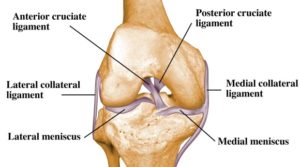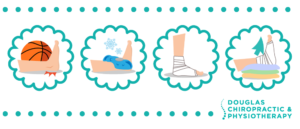
Knee injuries (more specifically knee ligament injuries) are responsible for about 1/3 of skiing injuries. The most commonly injured ligament is the MCL (Medial Collateral Ligament). The medial collateral ligament, or MCL, is located on the inside of one’s knee. It is a very strong ligament that prevents one’s knee from swinging to the outside against any forces on the knee. MCL tears are quite frequent, especially in skiing, and occur more than twice as often as ACL tears.

MCL tears typically occur due to excessive force on the opposite side of the knee, such as when a football player tackles another player from the side. As the outside of the knee goes inward due to excessive force, the MCL becomes strained and the fibers can partially or completely tear apart. Skiers using the “snow plow” position to stop may experience MCL tears due to the way in which the skis are turned. With the front of the skis pointed toward one another, the MCL is susceptible to tear if the inner edge of the ski catches and suddenly forces the knee into a further knocked knee position. The MCL can also tear when the lower leg is unexpectedly thrown outward (“catching an edge”).
Common symptoms of an MCL tear include pain/tenderness, stiffness and swelling. The knee may feel unsteady, or may lock or “catch.” Given its location the symptoms occur along the inner side of the knee.
To officially diagnose an MCL injury you have to see a doctor (Orthopedic surgeons are often experts in this field). Many times they can diagnose the injury just based on a physical exam. However, they will often order additional tests including X-rays and/or MRI. The X-rays are to help ensure there are no broken bones. The MRI can take a look at the actual ligament and some of the other soft tissues in the knee that don’t show up on a plain X-ray.
Ligament tears are often graded on a one through three scale.
Grade 1 Tear: The ligament is mildly damaged. The ligament has been slightly stretched with some fibers torn but most fibers still intact.
Grade 2 Tear: The MCL is usually partially torn and the knee is moderately unstable.
Grade 3 Tear. There is a complete tear of the ligament. Grade 3 MCL tears are also commonly associated with ACL tears.
Luckily, given its location the MCL is usually able to heal (it’s surrounded by a lot of blood vessels which help to bring it nutrients). In terms of treatment, most grade 1 injuries heal with rest as long as the knee is protected with a brace. If Grade 2 injuries are diagnosed early, they can usually heal with a hinged brace and activity modification in about six weeks. Activity modification means that patients need to avoid all cutting and pivoting activity and wear the brace continuously for six weeks. Depending on the severity of the grade 3 injury, these may require surgery.
Finally regardless of how severe the injury is good old “RICE” is helpful. This includes:

A useful exercise to use during recovery is a stationary bike because the spinning on a bike helps to align the new forming collagen fibers into better position and can also help restore motion and strength more quickly.
Another very common knee injury is the ACL (Anterior Cruciate Ligament) tear. The anterior cruciate ligament runs diagonally in the middle of the knee. It provides rotational stability to the knee. ACL injuries are most commonly associated with sports like football and basketball but are also common skiing and snowboarding injuries. Although better ski boots and bindings have led to improvements in helping prevent shin fractures and ankle injuries, these same improvements and their release mechanisms cannot catch or prevent a sudden sharp twist of the knee which can result in ACL tears.
The ACL is most commonly injured in the following ways: changing direction rapidly, stopping suddenly, slowing down while running, Landing from a jump incorrectly or direct contact or collision (think football tackle.)
When you injure your anterior cruciate ligament, you might hear a “popping” noise and you may feel your knee give out from under you. Other typical symptoms include pain with swelling, feeling that the knee is unstable, loss of full range of motion, pain along the joint line and discomfort while walking.
Once again seeing a doctor is important. Like the MCL, ACL injuries are graded on the same 3 point scale as above. Immediate treatment is the same and includes “RICE” and bracing the knee but unfortunately many ACL injuries do need repair, especially if you want to return to the same level of activity as before.
The best thing is to keep cautious of sharp turns, enhance the quadriceps muscle, and wear a knee brace when hitting the slopes.
Stay safe on the slopes!
*The views and opinions expressed herein are those of the author and do not necessarily reflect the views of MDLingo.com, its affiliates, or its employees.